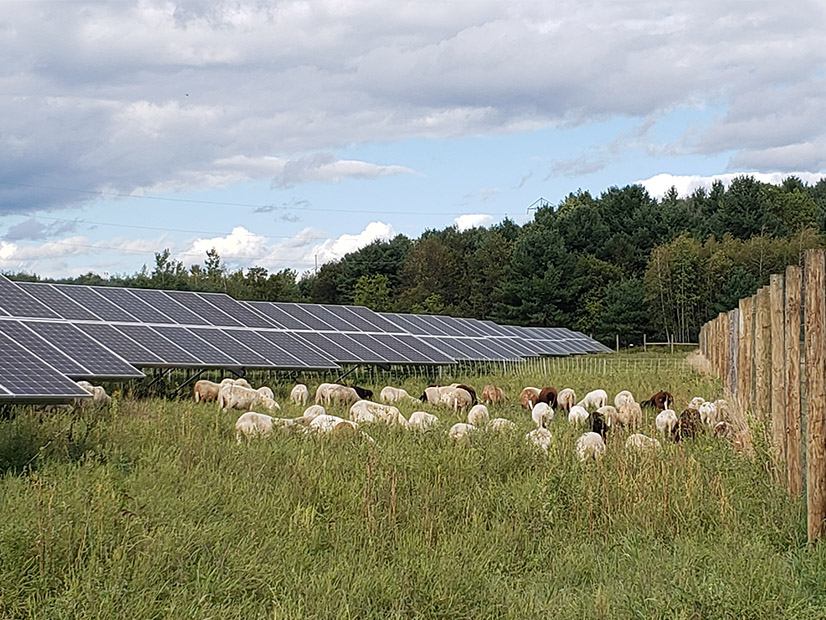
Maine and Massachusetts have vastly different installed solar generation capacities, but the two states are dealing with similar market issues as they work to meet their clean energy goals.
The Environmental Business Council of New England gathered industry experts on Thursday to discuss the status of solar in the Northeast, providing a look at key solar market trends playing out in Maine and Massachusetts.
Interconnection
Distributed generation interconnection and grid infrastructure investment, together, are “the single biggest impediment for continued [solar] success in Massachusetts and Maine,” Kelly Friend, vice president of policy and regulatory affairs at solar developer Nexamp, said during the webinar.
The two states, which are Nexamp’s primary New England markets, are not alone in their struggles to find a good pathway for how DG can quickly and affordably connect to the grid. While interconnection costs can be low in nascent DG markets, Friend said, the costs usually go up over time, depending on prior grid investments.
“We’re seeing that in Massachusetts, and particularly in Maine,” she said.
Some projects can trigger the need for a grid upgrade on a congested part of the system, which can increase the project’s interconnection cost by millions. And it can take a long time to get through an interconnection queue when grid studies hold up the process.
Massachusetts currently has 3,380 MW of installed solar capacity and Maine has 280 MW, according to the Solar Energy Industries Association.
Nexamp operated in Massachusetts for about five years before it began to see interconnection issues there in about 2018, according to Friend. In Maine, she said, it happened much faster. The state’s DG program opened in about 2019, and similar issues arose after about a year.
“That’s a result of the load profiles of both states and the investments in the grid that the utilities hosting those projects and interconnecting those projects have made,” she said.
Figuring out the interconnection conundrum is critical for achieving net-zero goals and signaling developers that they can move forward with business.
“Until we see signs of clear and consistent progress on interconnection, it’s very hard for us to think about Massachusetts growing at the rate we want to see it grow and need to see it grow from a climate perspective, because the cost and time to interconnect these projects is just so significant,” Friend said.
Nexamp is trying to take the lessons it has learned in Massachusetts and export them to Maine to ensure that projects there aren’t triggering huge interconnection costs and experiencing regulatory lag time in five years.
Regulatory Responses
In Massachusetts, some projects are seeing burdensome interconnection costs, and grid studies have left other projects in the queue for up to three years, according to Eric Steltzer, director of the Renewables and Alternative Energy Division at the Massachusetts Department of Energy Resources (DOER).
The Department of Public Utilities, in response, opened a docket (20-75) last fall to investigate the problems and present options for resolving them.
Regulators issued a straw proposal within the docket that incorporates DG planning into distribution system planning. The proposal also outlines a pathway for cost allocation of transmission upgrades that goes through the distribution system owner’s capital investments and becomes a fee to all interconnecting facilities that benefit from the upgrade.
DOER supports the straw proposal, and stakeholders are awaiting an order from the DPU in that docket, Steltzer said.
Maine is also trying to resolve its solar project interconnection problems through a Maine Public Utilities Commission investigation.
“Earlier this year, when CMP [Central Maine Power] issued some pretty shocking prices related to interconnecting solar projects, the governor sent a letter to the PUC asking them to look into what was going on with CMP’s interconnection process,” Celina Cunningham, deputy director of the Maine Governor’s Energy Office, said during the webinar.
The PUC issued a notice for the formal investigation (2021-00035) in April and held a series of hearings throughout the summer. The proceedings sought clarity on why CMP (NYSE:AGR) told some developers with signed interconnection agreements that they would incur significant, unanticipated grid upgrade costs.
PUC staff issued a bench memorandum on Sept. 21 that essentially found CMP did not properly anticipate the effect that a 2019 law (LD 1711) designed to encourage solar development would have the grid. Staff asked for comments on the basis for and potential calculation of penalties. Staff will issue additional recommendations in an examiner’s report after reviewing those comments.
In its comments on the memorandum Tuesday, CMP said that it has revised its estimated upgrade costs and there is no evidence of harm to any solar developers from its actions. The utility also said there is no basis for imposing a penalty.
Solar and Agriculture
Maine and Massachusetts are working on independent initiatives that will help them understand how to incentivize solar development in harmony with the agricultural sector.
Massachusetts proposed changes on Oct. 6 to its dual-use guidelines for projects under the Solar Massachusetts Renewable Target (SMART) program, according to Steltzer. Dual-use projects, which site solar on land designated for agricultural practices, receive a 6-cent/kWh adder under the SMART program.
The draft guidelines would, among other things, set a goal of 80 MW for dual-use projects, increase the eligible system size to 5 MW and require new farms to be operational for three years to qualify for the adder, Steltzer said.
DOER is accepting comments on the draft guidelines until Oct. 27.
In Maine, a stakeholder group has been studying solar and agricultural lands since June. The Governor’s Energy Office is co-chairing the group to look at “how to balance the use of Maine farmland … and development of solar and putting forward a number of recommendations,” Cunningham said.
The group wants to identify and prioritize different types of lands, identify farmland stressors and understand the lifecycle of solar projects on lands that could revert to agriculture.
A report is due in December, and the group’s next meeting is on Oct. 21.

